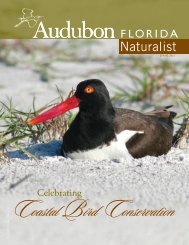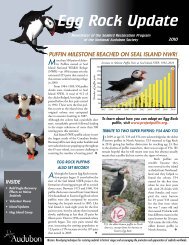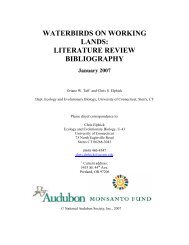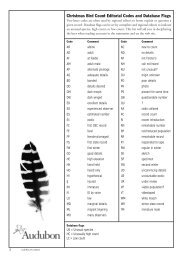CTION
Annual Report pdf for website.indd - National Audubon Society
Annual Report pdf for website.indd - National Audubon Society
- No tags were found...
Create successful ePaper yourself
Turn your PDF publications into a flip-book with our unique Google optimized e-Paper software.
sTaTes2. Farmingfor the BirdsWith almost half of its100 million acres in eithercrops or grazing, Californiaranks first amongu.S. states in agriculturalproduction. That production,however, has comeat a high cost for wildlife:the loss of 95 percent ofthe wetlands that migratingwaterfowl, shorebirds,and other species dependon. In the Central Valley,many birds now turn torice farms as alternativehabitat; these landsnow represent more than80 percent of availablewetlands in winter. That’swhy Audubon California ispartnering with individualrice growers and otherstakeholders, includingthe Natural ResourcesConservation Service,The Nature Conservancy,PRBO Conservation Science,and the CaliforniaRice Commission, toensure that these floodedrice fields are managedin ways that also supportbird populations. To datenearly 200 California ricegrowers have signed upfor this innovative CentralValley program. For suchAudubon priority speciesas Black-necked Stilts,Western Sandpipers, LongbilledCurlews, and SandhillCranes, the benefit ishealthy, welcoming winterand stopover habitat.iNTerNaTiONaL3. Chile: Protecting working LandsThe remote ChiloéArchipelago, locatedoff the central coastof Chile, encompassesastonishing marineand coastal biodiversity. The island chain’scoastal wetlands play a critical role in thelifecycle of many birds, serving as winter hometo virtually all Hudsonian Godwits in the PacificFlyway as well as to 61 percent of all Pacificbreeding Whimbrels. Audubon is working withour Chilean conservation partner CeCPAN (elCentro de estudios y Conservación del PatrimonioNatural) to engage private landownersto implement land management practices thatprotect shorebirds, improve water quality, andbalance agriculture with conservation.1BLaCk oySTerCaTCHeran audubon California surveyof Black oystercatchers, whichlive on rocky shores from alaskato Baja, found 1,346 birds—farhigher than previous estimates.AuduBON 2012 ANNu AL RePORT 25








![Full report [PDF] - the Boreal Songbird Initiative](https://img.yumpu.com/52893853/1/190x259/full-report-pdf-the-boreal-songbird-initiative.jpg?quality=85)

